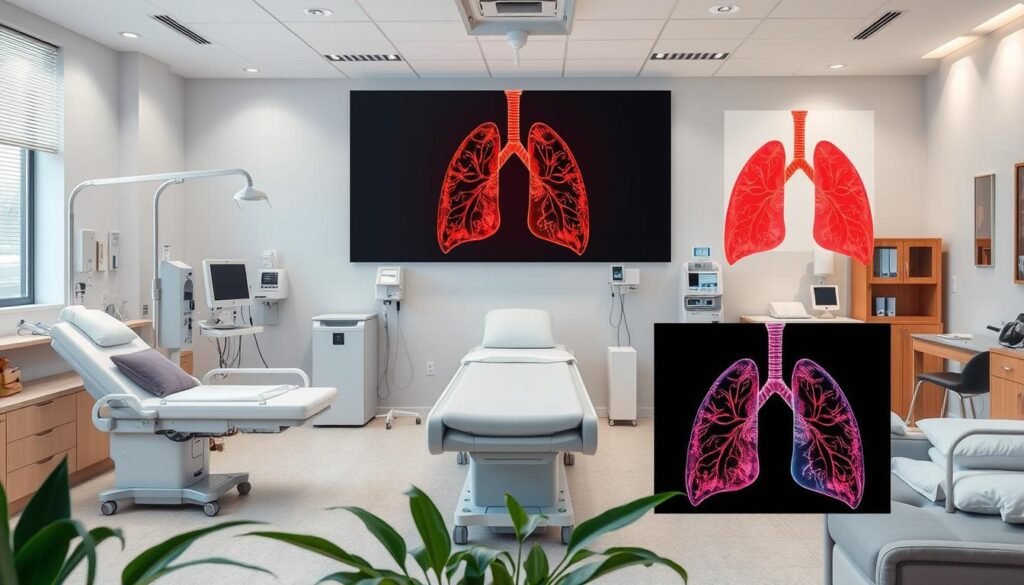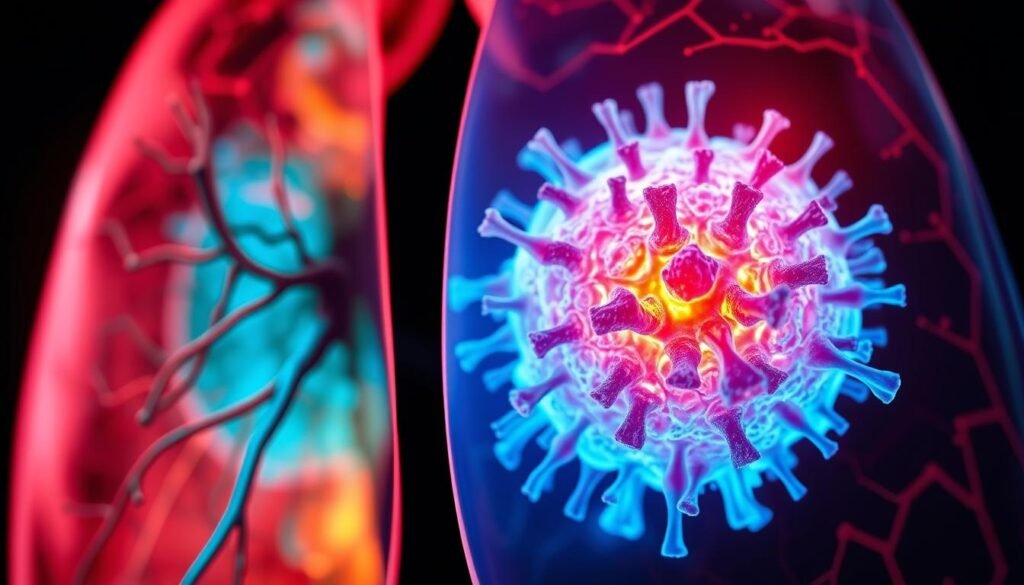Did you know the five-year survival rate for treated stage 2 non-small cell lung cancer (NSCLC) is about 35 percent? Though this number gives us some insight, it’s just the beginning. Stage 2 NSCLC marks a critical point where treatment can really make a difference.
Life expectancy with stage 2 non-small cell lung cancer depends on many things. These include tumor size, location, and the patient’s overall health. At this stage, there are more ways to treat the cancer. But, it’s also important to understand what the prognosis means for those diagnosed.
In this article, we dive into the factors influencing life expectancy for non-small cell lung cancer. We’ll look at survival rates and treatments available. Our goal is to help those affected make well-informed decisions on their journey.
Key Takeaways
- Stage 2 NSCLC has an approximate five-year survival rate of 35% when treated.
- This stage involves tumors ranging from 4 to 7 cm in size.
- Early detection significantly improves lung cancer prognosis.
- Surgery is generally recommended for healthy individuals diagnosed with stage 2 NSCLC.
- Factors like tumor size and patient health greatly affect survival rates.
- Support groups provide valuable resources and emotional backing for patients.
- Understanding the specifics of each NSCLC substage can guide treatment decisions.
Understanding Non-Small Cell Lung Cancer (NSCLC)
Non-small cell lung cancer is the leading type of lung cancer. It makes up about 80–85% of all lung cancers. Knowing the types like adenocarcinoma, squamous cell carcinoma, and large cell carcinoma is key. It helps give an accurate lung cancer diagnosis.
Knowing about non-small cell lung cancer helps doctors predict outcomes and plan treatments. This cancer has stages 0 through 4. Earlier stages often mean a better chance of survival. For instance, the 5-year survival rate for local non-small cell lung cancer can be about 65% with the right treatment.
Finding lung cancer early greatly improves chances of beating it. Tools like CT scans, PET scans, and MRIs play a big role in finding out if the cancer is there and how far it has spread. High-risk groups are advised to get screened regularly with low-dose CT scans. This helps catch non-small cell lung cancer early when it’s easier to manage.
Stage 2 Non Small Cell Lung Cancer Life Expectancy
Learning about the survival rates for stage 2 non-small cell lung cancer (NSCLC) is helpful for patients and their families. It’s key to look at general stats and also personal diagnosis details. Stage 2 NSCLC is split into stage 2A and 2B. This is based on tumor size and if lymph nodes are involved.
Overview of Survival Rates
The survival rates for stage 2 NSCLC vary by person. On average, people with stage 2 lung cancer have a five-year survival rate between 53% and 60%. Stage 2A patients have about a 60% chance, while stage 2B’s chance is around 53%. This info helps guide treatment choices. It shows why catching cancer early is so crucial. This is further touched upon in lung cancer statistics.
Five-Year Survival Statistics
Based on SEER data, stage 2A lung cancer’s five-year survival rate is about 59%. Stage 2B, however, has a much lower rate of about 31.7%. Things like how well treatment works, overall health, and lifestyle changes greatly affect these numbers. For example, quitting smoking can boost survival rates to nearly 70% for those with stage 2 NSCLC.
Lung Cancer Staging and Classification
Lung cancer staging is key to understanding how severe the illness is and planning treatment. It is important for both patients and doctors to know the lung cancer categories. The TNM staging system is used to classify lung cancer. It looks at tumor size (T), if the cancer has reached lymph nodes (N), and if it has spread elsewhere (M).
TNM Staging System
The TNM system places lung cancer into stages by looking at the tumor and how far it has spread. Here’s what each part of the system means:
- T (Tumor): Shows how big the main tumor is.
- N (Nodes): Tells if cancer has reached close lymph nodes.
- M (Metastasis): Indicates if cancer has spread far from its origin.
Stage Breakdown for Non-Small Cell Lung Cancer
Stage 2 non-small cell lung cancer (NSCLC) is split into two groups. Each group has different traits that affect treatment options and chances of getting better:
| Stage | Tumor Size | Lymph Node Involvement |
|---|---|---|
| Stage 2A | 4-5 cm | No lymph node involvement |
| Stage 2B | Smaller than 3 cm with lymph node spread or 3-5 cm with local extension | Presence of lymph node spread |
Understanding the differences in staging is critical for planning the best treatment. Studies show that survival rates vary a lot based on the cancer stage and how much it has spread. This highlights the importance of catching the disease early and starting treatment as soon as possible.
Factors Influencing Life Expectancy
Understanding the factors that affect life expectancy in stage 2 non-small cell lung cancer (NSCLC) patients is crucial. Tumor traits play a big role in predicting the outlook. However, the overall health of the patient is equally important. These aspects can shed light on treatment outcomes and how long patients can expect to live.
Tumor Size and Location
The tumor’s size and where it’s located can greatly affect prognosis. Big tumors that spread to nearby tissues often mean a worse outlook. Tumors in parts of the lung that are hard to reach surgically also decrease life expectancy. This highlights the need for early detection and effective treatment.
Patient’s Overall Health
A patient’s overall health matters a lot. It includes age, fitness, and whether they have other health issues. People in better health tend to do better during treatment and have a better chance of living longer. Living a healthy lifestyle can also improve how well treatment works and increase life expectancy.
The patient’s age when diagnosed is important, too. Younger patients often recover better and live longer than older ones.
Lung Cancer Prognosis
The outlook for people with stage 2 non-small cell lung cancer (NSCLC) changes a lot. It depends on the tumor’s traits and the patient’s health. Stage 2 means the cancer is at a middle phase. Patients can choose from many treatments, improving their chances.
Impact of Disease Progression
For stage 2 NSCLC, survival rates after treatment are 36-46% for 2A and 25-36% for 2B. This is better than stage 4 NSCLC, where survival drops to 2-13% over five years. It shows how vital early detection and treatment are.
Prognosis Variability Among Patients
The outlook also changes based on age, health, and treatment response. For example, stage 2 NSCLC has a five-year survival rate of about 65% if it’s localized. But this falls to 37% if it has spread to nearby regions. It underlines the need for customized treatment plans.
Lung Cancer Treatment Options
Treatment for stage 2 non-small cell lung cancer (NSCLC) varies, catering to each patient’s needs. Surgery often begins the treatment, including methods like lobectomy or wedge resection, based on the tumor size and patient’s health.
After surgery, doctors usually suggest chemotherapy to boost survival rates. If surgery isn’t an option or someone prefers not to go that route, targeted therapy and immunotherapy are cutting-edge choices. Especially, immunotherapy has been a breakthrough, offering better results for patients.
Talking to healthcare providers about lung cancer treatment options is crucial. It helps create a detailed plan that fits personal health situations. Each method brings its own advantages and possible risks, highlighting the need for tailored care.

Survival Rates for Stage 2 NSCLC
Understanding survival rates for stage 2 non-small cell lung cancer (NSCLC) is key for patients and families. It helps gauge treatment outcomes and set realistic hopes. Stage 2 NSCLC survival rates show a better prognosis than later stages, though many factors play a role in individual results.
Five-Year Survival Rate by Substage
The five-year survival rates for stage 2 NSCLC vary by substage. For stage 2A, the survival rate stands at about 60%. For stage 2B, it’s between 40% to 55%. Knowing these details is crucial for patient care and adjusting treatments. The average lifespan for stage 2 NSCLC is around 11 to 13 months. With effective treatments, this time can be extended.
Statistics Comparison with Other Stages
Stage 2 NSCLC offers more promise when compared to other stages. Early detection, including stages 1 and 2, shows a lifespan of 33 to 55 months. Stage 3 patients have about 12 to 28 months. Stage 4, however, is much more severe with only 4 to 9 months. This highlights the critical role of early detection and treatment.
| Stage | Life Expectancy (Months) | Five-Year Survival Rate (%) |
|---|---|---|
| Stage 1 | 33-55 | Not specified |
| Stage 2 | 11-13 | 53-60 |
| Stage 3 | 12-28 | Not specified |
| Stage 4 | 4-9 | Not specified |
For more info on stage 2 NSCLC, including survival rates and treatments, visit this resource.
The Importance of Early Detection
Finding lung cancer early improves the chance of beating it. When found early, there are more and better treatment options. Early-stage lung cancer patients usually live much longer than those found later.
Getting diagnosed quickly means treatments can start sooner. This increases the chance of full recovery.
Benefits of Timely Diagnosis
Discovering lung cancer early means quick treatment can start. Some benefits of finding it early include:
- Enhanced survival rates for patients with tumors that haven’t spread.
- Many treatment choices like surgery, chemotherapy, and targeted therapies.
- Opportunities to try new treatments in clinical trials.
- Better confidence for patients and families due to effective treatments.
Screening, especially for people who smoked a lot, can spot lung cancer early. The American Cancer Society says yearly scans can find it before symptoms show. This leads to earlier treatments.
Screening Methods and Guidelines
Low-dose CT scans are key to finding early lung cancer. They’re for people 50 to 80 who smoked heavily. This method helps spot cancer early. It also highlights the need for good facilities to handle results.
Other new tests, like liquid biopsies, might improve detection. But, lung cancer screening faces hurdles. These include biases in who participates. Age, wealth, and fear can affect screening. Overcoming these issues is crucial to catch lung cancer early and save lives.

Recent Advances in Treatment
New treatments for stage 2 non-small cell lung cancer (NSCLC) have changed patient care greatly. Targeted therapies and immunotherapy are now key. They focus on certain genetic mutations and the immune system. These new methods work better and have fewer bad side effects than old treatments.
Targeted Therapies and Immunotherapy
Targeted therapies play a big role in treating lung cancer, especially NSCLC. They stop cancer growth by targeting specific changes in the cancer. Recent studies have found success with drugs approved by the FDA that target EGFR, ALK, and VEGF. When these are combined with immunotherapy, patients tend to do much better.
Survival Improvement Metrics
It’s important to look at how new treatments are helping people live longer. Studies show a big increase in the five-year survival rate for lung cancer patients thanks to these advances. Personalized medicine is helping patients live longer and better lives while they deal with lung cancer.
Lifestyle Factors Affecting Survival Rates
Lifestyle choices have a big impact on someone’s chances when fighting stage 2 non-small cell lung cancer (NSCLC). Knowing how your habits and health can change survival rates is key. It’s important to consider things like smoking and living a healthy life.
Impact of Smoking on Prognosis
Smokers have a tougher battle with lung cancer compared to non-smokers. About 80 percent of lung cancer deaths are due to smoking. If you quit smoking, your survival rates could go up. This shows how vital it is to stop smoking.
Men who smoke are 23 times more likely to get lung cancer. Women have a 13 times higher risk than those who don’t smoke. We can’t forget about secondhand smoke either. It causes over 7,000 non-smokers to die each year.
Importance of a Healthy Lifestyle
Living healthy helps a lot with lung cancer. Eating well and staying active makes treatment easier and helps with recovery. Researchers say good food and exercise can really improve your chances. Making these changes is a big part of getting better. Every healthy choice makes a difference.

| Lifestyle Factor | Impact on Survival Rates |
|---|---|
| Smoking | Significantly decreases survival rates; quitting can improve prognosis |
| Healthy Diet | Supports recovery and enhances treatment tolerance |
| Regular Exercise | Improves overall health and can lead to better outcomes |
| Alcohol Consumption | Excessive drinking can negatively affect health and recovery |
Resources for Patients and Families
Patients and their families fighting stage 2 non-small cell lung cancer (NSCLC) have many resources available. These resources help manage the emotional and practical issues of the disease. Information on treatments, lifestyle adjustments, and ways to cope are vital parts of these resources.
Support Groups and Networks
Support groups provide a space for lung cancer patients to share their stories and learn from others. These groups are often run by oncology social workers who help guide discussions. Through online platforms, patients can find support no matter where they are.
Educational Materials and Organizations
Educational resources are offered by reputable organizations to patients and families. The American Cancer Society, CancerCare, and LUNGevity deliver information on treatments and coping strategies. Workshops and webinars keep patients updated on new treatments, giving them the knowledge to tackle their disease.
| Type of Resource | Description | Examples |
|---|---|---|
| Support Groups | Peer-led groups for sharing experiences and emotional support. | Online support forums, local meeting groups |
| Educational Workshops | Informative sessions covering lung cancer topics and updates. | Connect Education Workshops, webinars |
| Meal Delivery Programs | Services providing nutritious meals to families dealing with cancer. | Magnolia Meals at Home |
| Counseling Services | Professional counseling for emotional and financial challenges. | CancerCare, financial assistance resources |
Conclusion
Knowing about stage 2 non-small cell lung cancer life expectancy is key for patients and families. Many factors affect prognosis, like tumor traits, how well treatments work, and lifestyle choices. Without treatment, average survival is about 8.4 months. But, timely treatment can make a big difference.
Survival stats can help people make informed health decisions. Catching cancer early is crucial for better treatment results. Patients can then explore treatments right for them. This leads to more effective health management despite lung cancer’s challenges.
Talking with doctors is essential for those with stage 2 non-small cell lung cancer. It helps tailor treatment plans and offers better insight into prognosis. Being informed and active in their care can greatly help patients. They can see better life expectancy and quality of life with the right support and information. For more on lung cancer, visit the American Cancer Society.